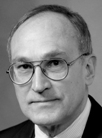

|

|
IN MEMORIAM
Henry E. Studer
Professor of Biological and Agricultural Engineering, Emeritus
UC Davis
1935 – 2011
Henry E. Studer made significant inventions of machines and systems for the mechanical harvest of grapes and other fruit. He grew up on a family dairy and fruit farm in up-state New York. He attended Cornell University, receiving a bachelor of science degree in 1959 and an M.S. degree in agricultural engineering in 1961. His M.S. thesis topic was on the mechanical harvesting of Concord grapes. In 1961 at Cornell he met his wife, Marjorie Ann Harley, who was studying for her M.A. degree in chemistry.
Upon graduation from Cornell, Studer joined the Agricultural Engineering Department at UC Davis to work on agricultural mechanization research. He was promoted to Professor in 1980, and served as department chair from 1986 to 1991. Studer cooperated with machinists, undergraduate and graduate students, fellow engineering faculty members and with plant scientists in his research. Important in this latter group was viticulturist, Professor Harold Olmo. Studer was also active in teaching of courses on agricultural machinery and on oil hydraulics for machine actuation and power transmission, as well as in guiding graduate students from many parts of the world.
Studer’s research on grape harvest included unique methods and equipment for imparting impact and vibration to grapes, vines and trellises, and included work on new raisin and currant production and drying methods, as well as on physical properties of fruit, vine and trellis materials. The extent of this research included bulk handling and sampling of grapes, as well as the management of grape processing waste. The findings from this research also found application in the harvesting of both fresh-market and processing tomatoes and of pistachios, as well as in the sun-drying of prunes. He came to the conclusion that the choice of trellising was the key to understanding the potential for mechanization of the harvest of any vine crop. In his travels to many parts of the world he would be found in the field examining the trellising methods in use in each particular location.
Studer was listed as the inventor or co-inventor on ten U.S. Patents. One of the most significant concepts involved in several of these patents was that of a rotary shaker characterized by rotary oscillation while freely revolving. This force-balanced design imparted vibration to the foliage of fruit trees or vines without incurring either vibratory or continuous forces between the foliage and the shaker prime-mover, and without the shaker/prime-mover unit having to stop forward motion in the process of foliage engagement. This mitigated the many serious mechanical and operational problems common to shaker harvesters in use prior to the appearance of Studer’s design. The application of this force-balanced rotary shaker design to the separation of tomatoes from ground-level-severed vines was so advantageous that it was adopted by most manufacturers of tomato harvesters.
Studer retired in 1994, and shortly thereafter became engaged in a career as a scholar and teacher of the universal international language of Esperanto. He was the vice president of the American Teachers of Esperanto and the President of the Esperanto Society of Sacramento (California). He helped organize state and national Esperanto congresses in Sacramento and Davis. He made Esperanto connections at conferences in Albania and in Mexico as well as with Davis’ sister city of Inoyama, Japan and Davis’ twin city of Wuxi, China. It was his objective to be able to communicate with others in a common language – not one associated with one particular nationality or another. He prepared talks in Esperanto on the production of wine grapes and of cotton in California. Studer also became fluent in French and especially enjoyed the visits he made with his father to the family’s paternal roots in the Alsace-Lorraine region of France.
Studer is survived by his wife of 48 years, their three daughters and their families including five grandchildren. He is also survived by his two sisters and their families.
The engineering creativity of Henry E. Studer was a key element in the major expansions of the grape and tomato industries that have taken place in California over the past forty years. His designs continue to play significant roles in mechanization developments for many other tree, bush and vine crops worldwide.